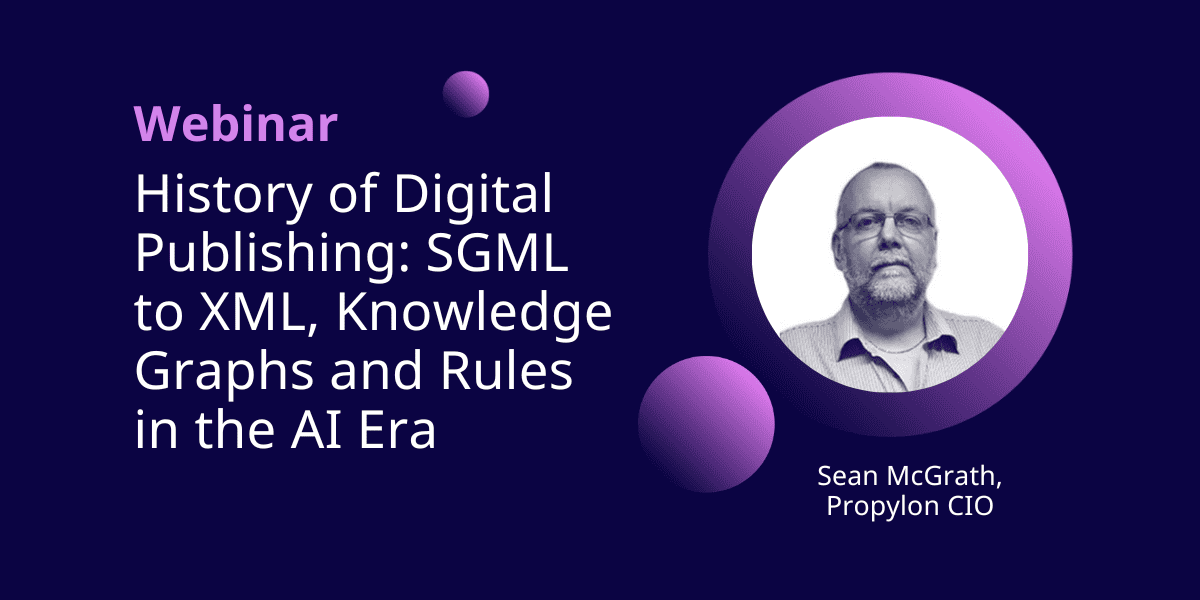In our latest webinar, Propylon Co-founder and Chief Innovation Officer, Sean McGrath, discussed his long career in digital publishing.
Beginning in the 1980s, Sean’s discovery of SGML inspired a lifelong passion for managing text in the online space, leading to a specialization in the world of rule-makers and rule-takers – the producers and key consumers of the laws, regulations and standards that make up the fabric of our societies.
In this interview spanning successive generations of technological development, Sean reviewed how the shifts in document management have revolutionized content creation, storage, and retrieval, especially in complex environments like legal publishing. He discussed the impact of desktop publishing technologies in the 1980s which allowed organizations to self-produce high-quality documents.
Sean highlighted the significance of knowledge graphs in modern-day content management, particularly for rule-makers and rule-takers. He explained how knowledge graphs, much like citation networks used by lawyers, allow users to map out complex interconnections between documents. The role of AI in modernizing the creation of laws, standards and guidance is crucial, transforming workflows by bringing context-based research directly into the authoring environment.
Explore some of the key moments from this webinar below.
The Beginning – From Personal Computers and Early Computing Practices to the Introduction of SGML
Reflecting on his early experiences with personal computing, Sean recalled his first computer, the Sinclair Spectrum ZX-80, which epitomized the home computing revolution of the 1980s. This era marked a significant shift as computers transitioned from large, centralized systems to accessible devices in households. During his university days, Sean observed that computers were primarily employed for practical applications such as payroll processing and time-sharing systems, showcasing their utilitarian role in business operations. It was during this time that he was introduced to SGML (Standard Generalized Markup Language), a pivotal moment that laid the foundation for his understanding of structured documents and the potential for organizing information in a systematic way. This early exposure to SGML would influence his future work in digital publishing and the development of XML standards.
Crafting the XML Standard
Recounting how he was invited to join the World Wide Web Consortium (W3C), Sean noted how this opportunity allowed him to contribute directly to the crafting of XML. This standard was designed to facilitate the structured interchange of data across different systems, making it easier for publishers and developers to create, share, and manage content in a digital environment. Sean’s involvement in this foundational project not only underscored the significance of XML in enhancing the accessibility and interoperability of electronic documents but also positioned him at the forefront of a transformative movement that continues to shape the landscape of digital publishing today.
The Desktop Publishing Revolution from the Apple LaserWriter to PDF and CD-ROM
In discussing the desktop publishing revolution, Sean emphasized the impact of the Apple LaserWriter, which fundamentally changed document production. This innovative printer revolutionized the way documents were created and produced, allowing users to design and print high-quality materials directly from their computers. The introduction of PDF and CD-ROM technology revolutionized the distribution and accessibility of digital content, empowering individuals and businesses to produce high-quality publications without the need for costly printing services. This democratization of publishing paved the way for new forms of media and increased access to information.
The Advent of the World Wide Web
The advent of the World Wide Web is identified by Sean as a pivotal moment for digital publishing. He described how the Internet fundamentally changed the way information is shared and consumed, breaking down traditional barriers to access. This shift allowed publishers to reach a global audience instantly, revolutionizing content distribution and enabling a more dynamic interaction between creators and consumers. The World Wide Web introduced new possibilities for multimedia integration and interactive content, fostering an environment where digital publishing could flourish. Sean emphasized that this transition not only democratized information access but also reshaped the landscape of publishing, paving the way for innovative practices and technologies that continue to evolve today.
The Role of AI and Knowledge Graphs in Digital Publishing Today
Next, Sean highlighted the critical role that AI and knowledge graphs play in the contemporary landscape of digital publishing. He underscored the growing demand for systems that not only facilitate information retrieval but also provide context and relevance to users. Knowledge graphs, with their ability to map relationships between concepts, enable more intuitive access to information and help users navigate complex datasets. Sean emphasized that integrating AI into publishing processes enhances content creation and curation, allowing for personalized experiences that cater to the specific needs of users. This combination of AI and knowledge graphs is restructuring how digital content is managed, presented, and utilized, making it more aligned with the intricacies of user queries and preferences.
Understanding Subject Matter Experts
Emphasizing the importance of the role of subject matter experts (SMEs) in digital publishing, Sean noted that SMEs possess valuable knowledge that must be effectively captured and organized. Technology should be designed to accommodate the way SMEs think and work, rather than forcing them to conform to a more technical mindset. The goal is to create user-friendly systems that allow SMEs to share their expertise without being overwhelmed by technical jargon, thus bridging the gap between content creation and structured data management.

